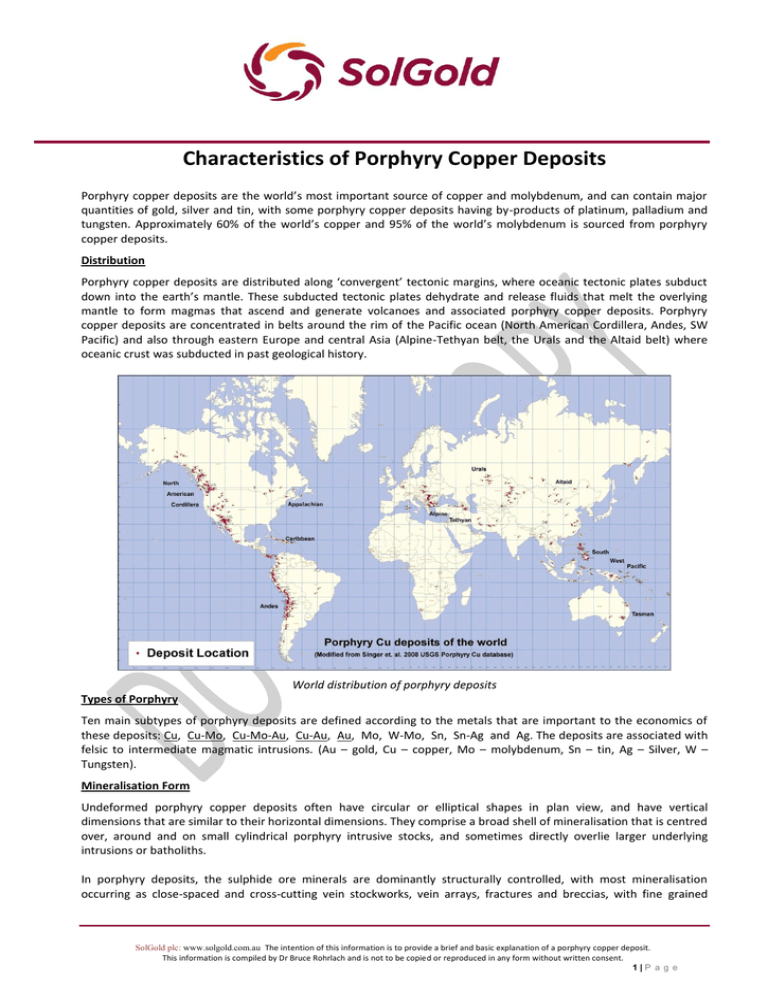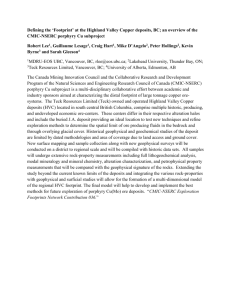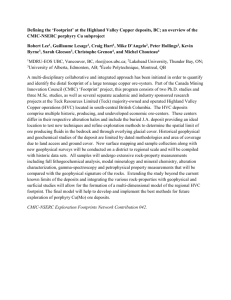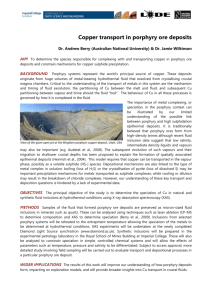Characteristics of Porphyry Copper Deposits
advertisement

Characteristics of Porphyry Copper Deposits Porphyry copper deposits are the world’s most important source of copper and molybdenum, and can contain major quantities of gold, silver and tin, with some porphyry copper deposits having by-products of platinum, palladium and tungsten. Approximately 60% of the world’s copper and 95% of the world’s molybdenum is sourced from porphyry copper deposits. Distribution Porphyry copper deposits are distributed along ‘convergent’ tectonic margins, where oceanic tectonic plates subduct down into the earth’s mantle. These subducted tectonic plates dehydrate and release fluids that melt the overlying mantle to form magmas that ascend and generate volcanoes and associated porphyry copper deposits. Porphyry copper deposits are concentrated in belts around the rim of the Pacific ocean (North American Cordillera, Andes, SW Pacific) and also through eastern Europe and central Asia (Alpine-Tethyan belt, the Urals and the Altaid belt) where oceanic crust was subducted in past geological history. World distribution of porphyry deposits Types of Porphyry Ten main subtypes of porphyry deposits are defined according to the metals that are important to the economics of these deposits: Cu, Cu-Mo, Cu-Mo-Au, Cu-Au, Au, Mo, W-Mo, Sn, Sn-Ag and Ag. The deposits are associated with felsic to intermediate magmatic intrusions. (Au – gold, Cu – copper, Mo – molybdenum, Sn – tin, Ag – Silver, W – Tungsten). Mineralisation Form Undeformed porphyry copper deposits often have circular or elliptical shapes in plan view, and have vertical dimensions that are similar to their horizontal dimensions. They comprise a broad shell of mineralisation that is centred over, around and on small cylindrical porphyry intrusive stocks, and sometimes directly overlie larger underlying intrusions or batholiths. In porphyry deposits, the sulphide ore minerals are dominantly structurally controlled, with most mineralisation occurring as close-spaced and cross-cutting vein stockworks, vein arrays, fractures and breccias, with fine grained SolGold plc: www.solgold.com.au The intention of this information is to provide a brief and basic explanation of a porphyry copper deposit. This information is compiled by Dr Bruce Rohrlach and is not to be copied or reproduced in any form without written consent. 1|P a g e disseminated sulphide mineralisation occurring between the veins and fractures. This morphology is produced by the rapid expansion of depressuring and boiling hydrothermal fluids that emanate out of the causative magmatic intrusion, and extensively fracture the country rock both above and around the intrusion. This process is repeated cyclically, resulting in very large and contiguous volumes of rock being mineralised by percolating magmatic fluids and interacting groundwater. Cross-section showing alteration zones around a porphyry system, and the vertical scale of the mineralising system which can span up to 8 km of the crust (modified from Sillitoe 1973). Lowell and Guilbert porphry copper model (1975) Associated Rock Alteration As a consequence of repeated mineralising events around the exterior margins of the porphyry intrusion, large volumes of rock are hydrothermally altered as they interact with the hot and acidic fluids that emanate from the intrusion and ascend through the overlying fractured country rock. These alteration haloes are much larger than the economic ore deposit, and can cover many tens of square kilometres within a district. SolGold plc: www.solgold.com.au The intention of this information is to provide a brief and basic explanation of a porphyry copper deposit. This information is compiled by Dr Bruce Rohrlach and is not to be copied or reproduced in any form without written consent. 2|P a g e The classic alteration zonation comprises a potassium silicate core (potassium feldspar or biotite alteration) within the intrusion and surrounded by a sericite (phyllic) alteration zone. This in turn may be surrounded by a clay-rich argillic alteration zone and then invariably by an outer zone of propylitic alteration comprising chlorite-epidote-calcite. The porphyry copper ore shell generally coincides with the inner potassic or phyllic alteration zones. At shallow levels, near the surface in un-eroded porphyry copper systems, a blanket or funnel of advanced argillic alteration (silica and acidstable clays) is present, can approach a couple kilometres in thickness and can cover up to many tens of square kilometres. Thus one of the main aims in exploration for porphyry systems is to understand this zonation from outcrop and drill hole observations, and to use this information to predict where the central mineralisation lies. Typical Size and Grade The copper and gold-bearing porphyry deposit subtypes are typically very large tonnage and of low to medium grade. Based on statistics in the United States Geological Survey (“USGS”) database of worldwide porphyry copper deposits, the 2008 median grade of 422 porphyry copper deposits was 0.44% copper while the median Mo grade was 0.013% (Singer et al., 2008). The 2008 median grade of by-product gold which was recovered from about two-thirds of these deposits was 0.21 g/t, with gold grades ranging from 0 to 1.3 g/t. The attractive economics of large porphyry copper deposits is based on the economy of scale of the mining operations that exploit them. These deposits typically comprise hundreds of millions to billions of metric tonnes of ore and are exploited by bulk mining techniques. Due to their large size, their mine lives typically span decades. Statistical size and grade of porphyry copper systems (USGS database) Vertical Extent and Implications for Exploration Ore zones in porphyry copper deposits typically form at depths between 1 and 6 km in the earth’s crust. The vertical extent of hypogene copper ore (i.e. un-modified by surface oxidation and metal redistribution) in porphyry copper systems is generally 1-1.5 km or less, although can substantially exceed this. The vertical scale of the alteration systems around porphyry mineralisation can be up to 8 km. i.e., Considering copper mineralised rock can extend down to 2 kilometres below the mined parts of porphyry systems, whilst up to 6 kilometres of overlying rock can be altered. The total volume of rock that can be affected by heat and/or fluid flow related to porphyry copper systems is much greater than the ore zones themselves, and can extend 10 km or farther outward from the centre of porphyry copper mineralisation. Because of the multi-kilometre vertical scale of porphyry copper mineralising systems, and the economic amenability of these deposits to underground mining, it is clear that the ability to find economic porphyry mineralisation is not and SolGold plc: www.solgold.com.au The intention of this information is to provide a brief and basic explanation of a porphyry copper deposit. This information is compiled by Dr Bruce Rohrlach and is not to be copied or reproduced in any form without written consent. 3|P a g e should not be limited to shallow drilling in the upper 300m of the crust, as might be the case for much smaller lowgrade Au deposits. The economies of scale afforded by porphyry systems allow them to be explored to depths that approach the limit of drilling capability, the only trade-off being mounting exploration cost with deep drilling. Mining Options Most porphyry copper deposits are mined by large scale open-cut mining methods. The two largest open-cut porphyry operations active today are at Chuquicamata in Chile (a 4 km x 2.5 km open-cut with an 11 km open-pit circumference) and at Bingham Canyon in Utah (image below). Because copper-mineralized rocks within porphyry systems can extend several kilometres deeper than the base of ore being mined in large open-cut operations, the base of ‘ore’ (i.e. being economically mineable) is dependent on factors such as copper grade, mining costs and mine design. In some deposits the base of ore represents the limit of drilling capability. A significant number of porphyry copper deposits are mined by underground methods, and typically involve block-cave methods. Some of the world’s largest blockcave underground mines are either in operation or planned on porphyry deposits. Some examples include: The world’s largest porphyry copper deposit – El Teniente (Chile), El Salvador (Chile), Oyo Tolgoi (Mongolia), Resolution (Arizona), Urad-Henderson (Colorado), Cadia East and North Parks (Australia) and Santo Tomas II (Padcal – Philippines). Bingham Canyon porphyry Cu-Mo mine, Utah. These large scale underground mines produce from deposits with copper grades of just over 1% copper and at cut-off grades of below 0.6% copper. Due to the economies of scale of these enormous operations, direct underground mining costs are of the order of $1 (US) per tonne. Additional Benefits of Exploring for Large Porphyry Copper Deposits Due to the very large scale of the magmatic and hydrothermal systems that drive the formation of porphyry copper mineralisation, a number of other deposit styles also form within the same broad environment as the porphyry systems themselves. These other deposit styles form at shallower levels in the crust and at varying distances lateral to porphyry deposits. These include high-sulphidation epithermal Au-Ag-Cu deposits, intermediate sulphidation Au-Ag-Cu-Pb-Zn deposits, distal low-suphidation epithermal Au-Ag deposits, contact skarn Cu/Au deposits and distal sediment-hosted Au deposits. This combination of potential deposit types make exploration for porphyry ‘systems’ highly attractive from an economic and risk perspective. The intention of this information is to provide a brief and basic explanation of a porphyry copper deposit. This information is compiled by Dr Bruce Rohrlach and is not to be copied or reproduced in any form without written consent. SolGold plc: www.solgold.com.au The intention of this information is to provide a brief and basic explanation of a porphyry copper deposit. This information is compiled by Dr Bruce Rohrlach and is not to be copied or reproduced in any form without written consent. 4|P a g e



